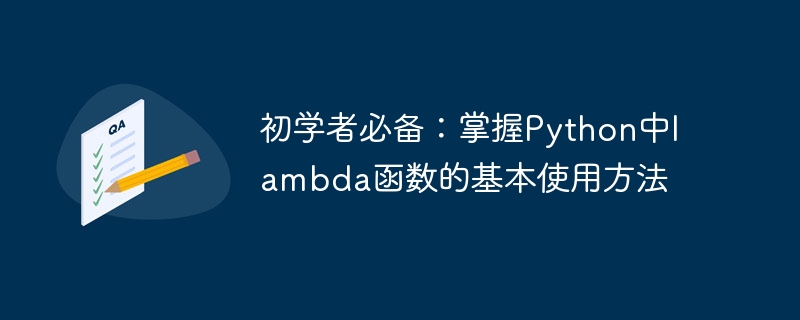

Must-have for beginners: Master the basic usage of lambda functions in Python, specific code examples are required
Overview:
Python is a simple and easy-to-learn programming Language, which has attracted the love of many programmers with its concise and flexible syntax. In Python, a lambda function is a special anonymous function that can be defined directly where the function is required without giving it a name. This article will introduce the basic usage of lambda functions and provide specific code examples to help beginners better understand and master lambda functions.
The syntax of lambda function:
The syntax of lambda function is relatively concise. The general form is: lambda parameter list: expression. The parameter list and expression are the two main parts of the lambda function.
Parameter list:
The parameter list is the input parameter accepted by the lambda function and can contain zero or more parameters. Parameters can be variables of any type, functions, lists, tuples, etc.
Expression:
Expression is the execution logic of the lambda function. It is a concise line of code that usually contains a return value. You can use any Python syntax to implement logical judgments, operations, function calls, etc.
Basic usage:
The following uses some specific examples to demonstrate the basic usage of the lambda function.
Example 1: Calculate the sum of two numbers
sum = lambda x, y: x + y result = sum(10, 20) print(result) # 输出30
Example 2: Calculate the average of three numbers
average = lambda x, y, z: (x + y + z) / 3 result = average(10, 20, 30) print(result) # 输出20.0
Example 3: Sort a list
students = [
{'name': 'Alice', 'age': 18},
{'name': 'Bob', 'age': 20},
{'name': 'Cindy', 'age': 15}
]
students.sort(key=lambda student: student['age'])
print(students)
# 输出:
# [{'name': 'Cindy', 'age': 15}, {'name': 'Alice', 'age': 18}, {'name': 'Bob', 'age': 20}]Example 4: Convert elements in the list to integers
numbers = ['10', '20', '30'] numbers = list(map(lambda x: int(x), numbers)) print(numbers) # 输出[10, 20, 30]
Summary:
The lambda function is a concise and flexible way to define functions in Python. It can be defined directly where the function is required, without giving it a name. The basic syntax of lambda functions includes parameter lists and expressions. The parameter list is the input parameter of the lambda function and can contain multiple parameters, while the expression is the execution logic of the lambda function and usually contains a return value. Through specific code examples, this article introduces the basic usage of lambda functions, hoping to help beginners better understand and master lambda functions.
The above is the detailed content of Python beginners must learn: Master the basic usage of lambda functions. For more information, please follow other related articles on the PHP Chinese website!




